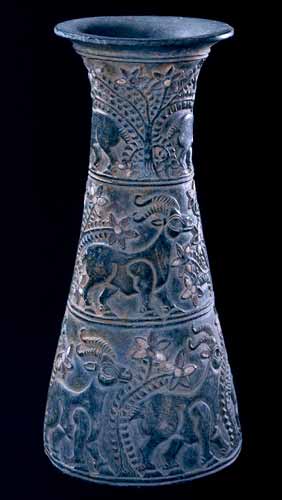Sumerian Chlorite Vase, 3000 BCE - 2000 BCE
Chlorite and Shell
10.5
PF.6212
Chlorite is a distinctive gray-green stone that was utilized during antiquity for the fabrication of luxurious containers in the greater Gulf region as well as southern Iran. Excavations at the...
Chlorite is a distinctive gray-green stone that was utilized during antiquity for the fabrication of luxurious containers in the greater Gulf region as well as southern Iran. Excavations at the archeological site of Tepe Yaya, dated to the mid-third millennium B.C., in Iran unearthed the ruins of workshops where such vessels were discovered. As well, raw materials used for their manufacture, chlorite as well as steatite, quarried from the nearby hills were also present. Found throughout the ancient Near East, from Syria to the Indus Valley, revealing the extensive trade routes of the time, these works are classified by modern historians as belonging to the “Intercultural Style.” Much like the written cuneiform alphabet was used by several distinct cultures throughout the ancient Near East to dictate their individual spoken languages, so such vessels were created by various cultures, each adorning the works with their own distinct aesthetic style. Many examples were discovered in the ruins of palace and temple structures or entombed in the graves of the nobility, including Sumerian Mesopotamia. Clearly these vessels were among the most precious luxury items that could only be afforded by the ruling elite. This tall conical vase with a flaring rim has been divided into three bands. Each band features the same decorative motif, horned antelopes flanked by flowering trees. The eyes of the antelopes and the pedals of the flowers have been inlaid with white shell, creating a charming effect. These motifs are consistent with the “Intercultural Style” which characteristically include vegetal, architectural, animal, and human themes.



